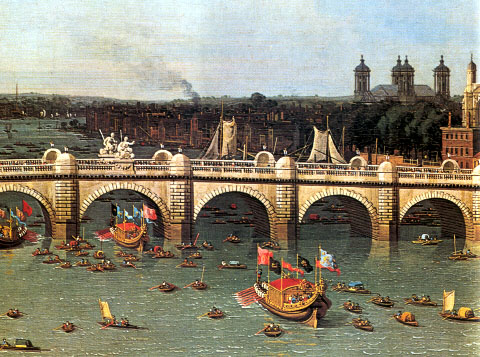2.32: Water Music
- Page ID
- 72563
Handel’s Water Music is a collection of three suites for orchestra. Our listening piece from this larger work is “Alla Hornpipe,” the 2nd movement from the Suite in D major. It is a perfect example of Handel’s emphasis on the louder, brass instruments that is heard throughout Water Music. After you read this page on the origins of the piece you’ll understand why Handel needed to boost the volume of Water Music as much as possible. “Alla Hornpipe” is written in ternary form (ABA) with the opening A section repeated once before the B section begins.
Introduction

The Water Music is a collection of orchestral movements, often published as three suites, composed by George Frideric Handel. It premiered on 17 July 1717 after King George I had requested a concert on the River Thames.
The Water Music is scored for a relatively large orchestra, making it suitable for outdoor performance. Some of the music is also preserved in arrangement for a smaller orchestra; this version is not suitable for outdoor performance, as the sound of stringed instruments does not carry well in the open air.
Structure
The Water Music opens with a French overture and includes minuets, bourrées and hornpipes. It is divided into three suites:
Suite in F major (HWV 348)
- Overture (Largo – Allegro)
- Adagio e staccato
- Allegro – Andante – Allegro da capo Aria
- Minuet
- Air
- Minuet
- Bourrée
- Hornpipe
- Allegro (no actual tempo marking)
- Allegro (variant)
- Alla Hornpipe (variant)
Suite in D major (HWV 349)
- Overture (Allegro)
- Alla Hornpipe
- Minuet
- Lentement
- Bourrée
Suite in G major (HWV 350)
- Allegro
- Rigaudon
- Allegro
- Minuet
- Allegro
There is evidence for the different arrangement found in Chrysander’s Gesellschaft edition of Handel’s works (in volume 47, published in 1886), where the movements from the “suites” in D and G were mingled and published as one work with HWV 348. This sequence derives from Samuel Arnold’s first edition of the complete score in 1788 and the manuscript copies dating from Handel’s lifetime. Chrysander’s edition also contains an earlier version of the first two movements of HWV 349 in the key of F major composed in 1715 (originally scored for two natural horns, two oboes, bassoon, strings and continuo), where in addition to the horn fanfares and orchestral responses, the original version contained an elaborate concerto-like first violin part.
The music in each of the suites has no set order today.
First Performance
The first performance of the Water Music suites is recorded in the Daily Courant, a London newspaper. At about 8 p.m. on Wednesday, 17 July 1717, King George I and several aristocrats boarded a royal barge at Whitehall Palace for an excursion up the Thames toward Chelsea. The rising tide propelled the barge upstream without rowing. Another barge provided by the City of London contained about fifty musicians who performed Handel’s music. Many other Londoners also took to the river to hear the concert. According to the Courant, “the whole River in a manner was covered” with boats and barges. On arriving at Chelsea, the king left his barge, then returned to it at about 11 p.m. for the return trip. The king was so pleased with the Water Music that he ordered it to be repeated at least three times, both on the trip upstream to Chelsea and on the return, until he landed again at Whitehall.
King George’s companions in the royal barge included Anne Vaughan, the Duchess of Bolton, the Duchess of Newcastle, the Duke of Kingston, the Countess of Darlington, theCountess of Godolphin, Madam Kilmarnock, and the Earl of Orkney. Handel’s orchestra is believed to have performed from about 8 p.m. until well after midnight, with only one break while the king went ashore at Chelsea.
It was rumoured that the reason for the spectacular performance of the Water Music was purposed to help King George steal some of the London spotlight back from the prince, who at the time was worried that his time to rule would be shortened due to his father’s long life and was throwing lavish parties and dinners to compensate for it. In a long term, the Water Music’s first performance on the water was the King’s way of reminding London that he was still there and showing he could carry out gestures of even more grandeur than his son.
Contributors and Attributions
- Authored by: Elliott Jones. Provided by: Santa Ana College. Located at: http://www.sac.edu. License: CC BY: Attribution
- Water Music (Handel). Provided by: Wikipedia. Located at: http://en.Wikipedia.org/wiki/Water_Music_(Handel). License: CC BY-SA: Attribution-ShareAlike

